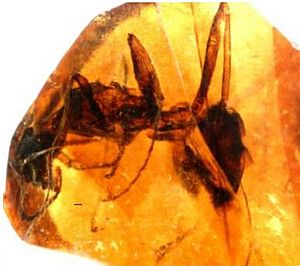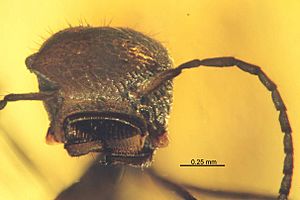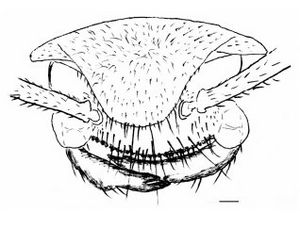Boltonimecia facts for kids
Quick facts for kids Boltonimecia |
|
|---|---|
 |
|
| B. canadensis holotype worker | |
| Scientific classification | |
| Genus: |
Boltonimecia
|
| Species: |
canadensis
|
| Synonyms | |
|
|
Boltonimecia is an extinct type of ant. It belongs to a special group of ants called Sphecomyrminae. There are only two known types of ants in its specific family group, called Zigrasimeciini. Boltonimecia only has one known species, called Boltonimecia canadensis. Scientists found a single fossil of this ant in Canada. It lived a very long time ago, during the Late Cretaceous period. This ant was first thought to be a different species, named Sphecomyrma canadensis.
Contents
Discovering an Ancient Ant
Boltonimecia is known from just one fossil. This fossil is a complete adult ant, called a holotype. It is preserved inside a small piece of amber. Amber is fossilized tree resin, like hardened sap. This amber piece is about 8 mm × 3 mm × 2 mm (0.315 in × 0.118 in × 0.079 in) in size.
Where the Fossil Was Found
The fossil was found in Canadian amber. At the time it was described, it was kept in a collection in Ottawa, Canada. The ant in the amber is a worker ant. It was found in the Taber coal zone. This area is near Grassy Lake and Medicine Hat, Alberta.
Canadian amber is very old. It dates back about 79 to 78 million years. This means the ant lived during the Campanian age of the Late Cretaceous period.
How Scientists Classified This Ant
Two worker ants were first studied in 1985 by a scientist named E. O. Wilson. He placed them in a different extinct ant group called Sphecomyrma. He named the species Sphecomyrma canadensis. The name "canadensis" refers to Canada, where it was found.
Later, in 1988, other scientists noticed something. They thought the two ants might not belong to the same group. In 1996, scientist Dlussky pointed out differences in the antennae. The antennae of "S." canadensis were different from S. freyi.
A New Name for an Old Ant
In 2017, scientist Leonid H. Borysenko re-examined the fossil. He found new details after carefully cleaning and polishing the amber. He realized this ant was unique. It needed its own new group, or genus.
Borysenko named the new genus Boltonimecia. This name honors myrmecologist Barry Bolton. Myrmecologists are scientists who study ants. Borysenko placed Boltonimecia into a new tribe called Zigrasimeciini. This tribe also includes a related ant group called Zigrasimecia.
Life in the Ancient World
Scientists can learn about ancient environments by studying amber. Canadian amber comes from cupressaceous trees. These trees grew in lagoons and salt marshes. These areas were along the Western Interior Seaway. This was a large inland sea that once covered parts of North America.
What the Ancient Habitat Was Like
The types of flies found in the amber tell us more. They suggest the ancient habitat had salt marshes and wet sandy areas. Tiny fossils called foraminiferan tests also support this. These fossils indicate the presence of brackish water. Brackish water is a mix of fresh and salt water. Even crocodylian scutes, which are like crocodile scales, have been found. This shows crocodiles lived nearby.
The trees that produced the amber were likely a species of Parataxodium. These trees are related to modern Taxodium and Glyptostrobus. They also preferred marshy, wet areas.
Other Ancient Ants from Canada
Boltonimecia canadensis is not the only ant found in Canadian amber. Other ant species discovered there include:
- Cananeuretus occidentalis
- Canapone dentata
- Chronomyrmex medicinehatensis
- Eotapinoma macalpini
- Haidoterminus cippus
What Boltonimecia Looked Like
The fossil worker ant is about 3.2 mm (0.13 in) long. Its head is about 0.73 mm (0.029 in) wide. Much of its body is the same color as the amber. However, some parts are darker, like brown or black. These include the lower part of its propodeum and the underside of its gaster (abdomen). Its legs also have dark parts. The top of its head and pronotum (part of its chest) are opaque black. The ant's outer shell, or exoskeleton, is smooth.
Head and Face Features
The head of Boltonimecia is small. It is wider than it is long. From above, it looks like a triangle. The top of its head is thick and shield-like. Two long parts stick out from the back of its head.
This ant either had very tiny eyes that are not visible, or no eyes at all. It also had no ocelli, which are simple eyes. The clypeus (a plate on its face) is small and curved. Its front edge has about 25 tiny, peg-like hairs. Each hair is only 0.01 mm (0.00039 in) long.
Mandibles and Antennae
The ant's mandibles (jaws) are strongly curved. They bend almost 90 degrees. The base of the mandibles is covered by the clypeus. Each mandible has two teeth at its end. One is smaller, and the other is larger. The larger tooth has a groove. This groove likely fit the opposite mandible when the jaws were closed.
The antennae of Boltonimecia have 11 segments. The first segment, called the scape, is curved. It reaches the back of the head when laid flat.



